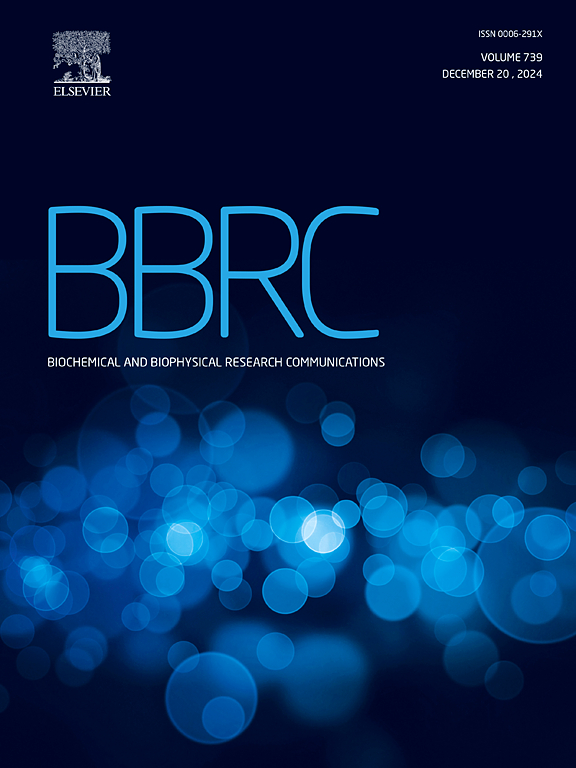尼卡文能增强同源重组缺陷癌细胞在 X 射线照射下的细胞毒性。
IF 2.5
3区 生物学
Q3 BIOCHEMISTRY & MOLECULAR BIOLOGY
Biochemical and biophysical research communications
Pub Date : 2025-01-01
DOI:10.1016/j.bbrc.2024.151153
引用次数: 0
摘要
聚(adp)核糖聚合酶(PARP)参与DNA单链断裂的修复。PARP抑制剂通过合成致死机制对同源重组(HR)缺乏的癌细胞具有细胞毒性。尼加拉瓜文是一种羟基自由基清除剂,已被研究用于治疗器官缺血,如脑梗死。在体内和体外也显示PARP抑制和抗癌活性。在这项研究中,我们研究了尼卡拉文对HR缺乏细胞的潜在合成致死性,以及尼卡拉文的PARP抑制和自由基清除活性是否有助于其抗癌作用,特别是在电离辐射暴露的情况下。结果表明,在敲低HR因子BRCA1或RAD51后,尼卡拉文对癌细胞具有细胞毒性,表明尼卡拉文对HR缺乏的细胞具有合成致死作用。在对照细胞中,x射线照射诱导的DNA双链断裂(DSBs)在2 h时增加,并在24 h后基本修复,而尼卡拉文在x射线照射后24 h显著增加了残余DSBs的数量,尤其是在hr缺陷细胞中。在hr缺陷细胞中,Nicaraven治疗增强了x射线照射的细胞毒性,但在hr精通细胞中没有增强。这些数据表明,尼卡拉文与x射线照射的组合选择性地增加了x射线照射对hr缺陷癌细胞的细胞毒性作用。因此,尼加拉瓜文可能是一种有价值的癌症治疗药物,特别是与放射治疗联合使用时。本文章由计算机程序翻译,如有差异,请以英文原文为准。
Nicaraven enhances the cytotoxicity of X-ray irradiation in cancer cells with homologous recombination deficiency
Poly (ADP-ribose) polymerase (PARP) is involved in the repair of DNA single-strand breaks. PARP inhibitors are cytotoxic to cancer cells with homologous recombination (HR) deficiency through a synthetic lethality mechanism. Nicaraven is a hydroxyl radical scavenger that has been investigated for the treatment of organ ischemia such as brain infarction. Nicaraven also shows PARP inhibitory and anti-cancer activity in vitro and in vivo. In this study, we investigated the potential synthetic lethality of nicaraven in cells with HR deficiency and whether the PARP inhibitory and radical scavenger activities of nicaraven contributes to its anti-cancer effects, especially in combination with exposure to ionizing radiation. The results showed that nicaraven was cytotoxic against cancer cells after knockdown of the HR factors BRCA1 or RAD51, indicating that nicaraven exerted synthetic lethal effects on cells with HR deficiency. X-ray irradiation-induced DNA double-strand breaks (DSBs) increased at 2 h and were largely repaired after 24 h in control cells, whereas nicaraven significantly increased the amounts of residual DSBs 24 h after X-ray irradiation, especially in HR-deficient cells. Nicaraven treatment enhanced the cytotoxicity of X-ray irradiation in HR-deficient cells, but not that in HR-proficient cells. These data suggest that the combination of nicaraven with X-ray irradiation selectively increases the cytotoxic effects of X-ray irradiation on HR-deficient cancer cells. Thus, nicaraven might be a valuable agent for cancer therapy, particularly in combination with radiotherapy.
求助全文
通过发布文献求助,成功后即可免费获取论文全文。
去求助
来源期刊
CiteScore
6.10
自引率
0.00%
发文量
1400
审稿时长
14 days
期刊介绍:
Biochemical and Biophysical Research Communications is the premier international journal devoted to the very rapid dissemination of timely and significant experimental results in diverse fields of biological research. The development of the "Breakthroughs and Views" section brings the minireview format to the journal, and issues often contain collections of special interest manuscripts. BBRC is published weekly (52 issues/year).Research Areas now include: Biochemistry; biophysics; cell biology; developmental biology; immunology
; molecular biology; neurobiology; plant biology and proteomics

 求助内容:
求助内容: 应助结果提醒方式:
应助结果提醒方式:


